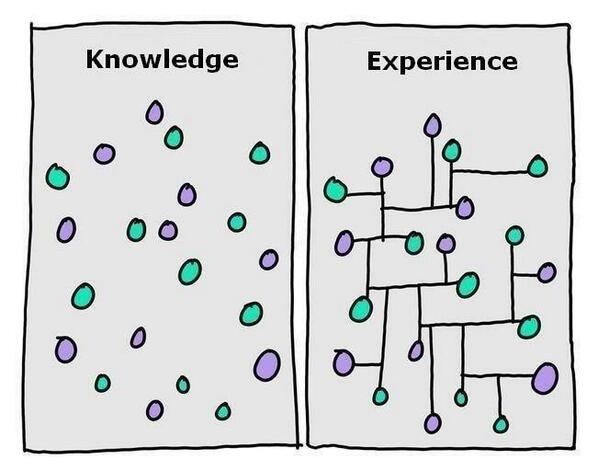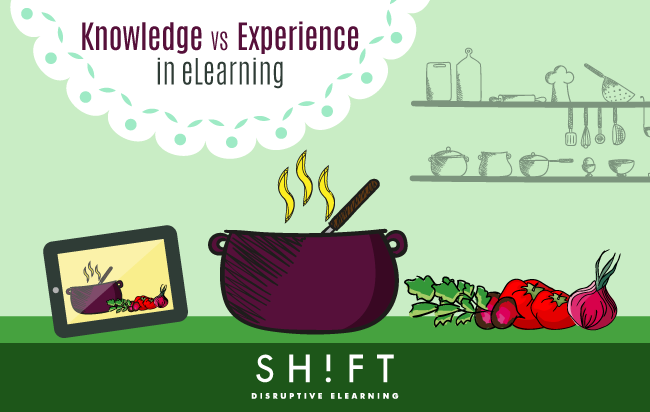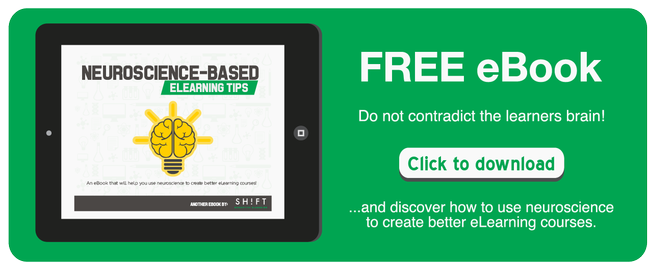Knowledge vs Experience
You may be a wizard with numbers, but what good is your knowledge if you cannot number-crunch your way through the mortgage documents? What good is any knowledge if you cannot apply it to solve novel problems that the training courses didn't teach you about?
Courses developed in the traditional manner only worry more about filling heads with knowledge. They are loaded with definitions and concepts and are probably accompanied by a list of scenarios or situations where these can be applied. The learners are expected to learn these by heart. But do business crises always turn out the way management books portray them? Can the chef never run out of ingredients when he is about to cook? Can you expect the opposing team to play the same way in every game? Do sales people deal with the same types of customers every day?
NO! Your learners are expected to "perform" at the workplace after they have taken your course, NOT blurt out facts or theories that they have memorized.
This image from Buffer's Blog makes the point clear:

As you can see in the image, knowledge is only useful if learners can make connections between what they know. Without experience, there will never be true knowledge.
Your Role
What does that mean for you as an eLearning professional? It’s simple. It means that you can develop an experience for practically any situation that will help bring home the concept you’re trying to deliver.
If you want your learners to be able to transfer the learning from the course to the desk, you have to make them think and act the way they are expected to perform in reality and at their workplaces. This means that instead of simply transferring knowledge on the learners and hope they will find "some" use for it, transform your learning content into real learning experiences. Albert Einstein summed it up in this one-liner: Learning is experience. And Charles Jennings said it differently "Think experience, practice and sharing rather than content, content, content."
The Benefits of Experiential Learning in eLearning
There are a number of reasons why experiential learning is so important to eLearning:
1) It betters information transfer by recreating reality.
Do you want your learners to know the names of the various components that make up a machine? Then just plunk down the list and ask them to memorize it. But if you want the learners to be also able to operate the machine and troubleshoot it, then create a simulation. Let the course mimic the interface of the machine, so the learners become familiar. Build in interactivities that let the learners engage with the interface, understand the workings of the machine, and see for themselves what happens when they press a button or pull a lever.
2) It motivates learners.
Experiential learning is motivating because learners immediately realize that they are learning skills that they can employ in real life. They see the learning outcomes being fulfilled and feel encouraged to continue with the course.
3) It improves comprehension and recall of the instructional content.
It is easier to remember a recipe if you cook the dish than if you try to memorize the ingredients and the steps in their sequential order. Research has shown that learning by doing improves comprehension and recall. Students remember 60 percent of the learning content with experiential learning compared to only 10 percent when they listen to a lecture.
4) It hones the critical thinking skills of the learners.
Because experiential learning discourages rote learning, learners are compelled to use their analytical skills to identify patterns, connect the dots, and think out-of-the-box to come up with solutions. They learn to tap into their existing knowledge and synthesize with the newly-learned information.
5) It creates life-long learners.
Experiential learning encourages learners to discover by exploring. Learners are made to confront unfamiliar situations that they will have to face in real life. This encourages them to analyze a problem, take stock of their knowledge, figure out the gaps, find out the ways in which they can acquire new and relevant information, and synthesize and apply the learning to arrive at a resolution. Experiential learning encourages learners to take control of the learning process and learn in the way they feel most comfortable. Self-directed learning helps them cultivate curiosity, which in turn, makes them learners for life.
Need more proof? 10 TED Talks that demonstrate the power of experiential learning
How Can You Weave in Experiential Learning in Your Courses?
Advances in digital technology help you incorporate experiential learning in eLearning courses easily and effectively. Using technology, you can create courses where learners learn and share knowledge like they would in real life, engage with realistic situations, and see the consequences of their actions in real time but without having to bear the costs of slips, mistakes, or wasted efforts.

Here are some tips to help you use technology to create experiential learning
- Encourage collaboration by incorporating social networking within the course. In an increasingly "social" world, we glean much of our knowledge from our peers on social networking sites. It is a world where learning takes place through sharing. When you weave in a "social" component in your eLearning course, you guide the learners to a familiar territory where they are comfortable learning.
- Use games. There is no better way to teach than when it takes place through games. Games are not only engaging but also provide ample opportunities for you to create realistic environments that the learners can explore and interact with.
- Include realistic scenarios. Scenarios that mimic real-life situations, problems, and interactions provide effective experiential learning platforms. Explore the learner's specific life situation to come up with plots they can relate to. Also try and weave in interactivities that simulate the way the learners consume information in real life. For instance, you can create experiences like answering phones, reading and writing emails, and attending meetings and interacting with other participants.
- Bring everyday situations into the online learning experience. For example you can include experiences like a role play, recording phone call, responding to emails within the scenario. You can also use video to simulate meetings, interviews, or difficult situations.
CONCLUSION:
Experiential learning lets learners hone their workplace skills in a safe and controlled environment. It ensures learning is contextual, realistic, engaging, and most effective.
eLearning designers must be open to new ways of attaining learning goals, emphasizing the creation of learner-focused environments that facilitate personal experiential learning activities.
Sources:
Towards Maturity Report: Online Experiential Learning: Helping Individuals Practice and Perform
Best Practices in Experiential Learning



